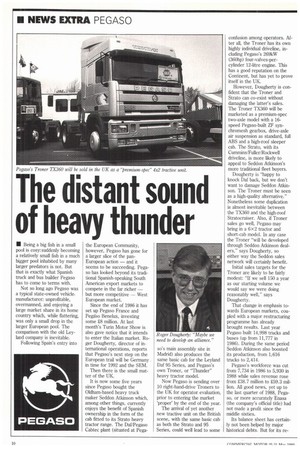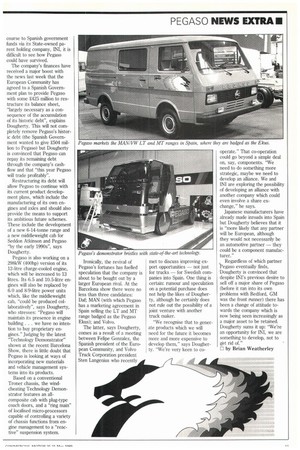The distant soun of heavy thunder
Page 12

Page 13

If you've noticed an error in this article please click here to report it so we can fix it.
• Being a big fish in a small pool is cosy: suddenly becoming a relatively small fish in a much bigger pool inhabited by many larger predators is not. But that is exactly what Spanish truck and bus builder Pegaso has to come to terms with.
Not so long ago Pegaso was a typical state-owned vehiclemanufacturer: unprofitable, overmanned, and enjoying a large market share in its home country which, while flattering, was only a small drop in the larger European pool. The comparison with the old Leyland company is inevitable.
Following Spain's entry into the European Community, however, Pegaso has gone for a larger slice of the panEuropean action — and it seems to be succeeding. Pegaso has looked beyond its traditional Spanish-speaking South American export markets to compete in the far richer — but more competitive — West European market.
Since the end of 1986 it has set up Pegaso France and Peggso Benelux, investing some £8 million. At last month's Turin Motor Show is also gave notice that it intends to enter the Italian market. Roger Dougherty, director of international operations, reports that Pegaso's next step on the European trail will be Germany in time for 1992 and the SEM.
Then there is the small matter of the UK.
It is now some five years since Pegaso bought the Oldham-based heavy truck maker Seddon Atkinson which, among other things, currently enjoys the benefit of Spanish ownership in the form of the cab fitted to its Straw heavy tractor range. The Daf/Pegaso Cabtec plant (situated at Pega so's main assembly site in Madrid) also produces the same basic cab for the Leyland Daf 95 Series, and Pegaso's own Troner, or "Thunder" heavy tractor model.
Now Pegaso is sending over 10 right-hand-drive Troners to the UK for operator evaluation, prior to entering the market 'proper' by the end of the year.
The arrival of yet another new tractive unit on the British scene, with the same basic cab as both the Strato and 95 Series, could well lead to some confusion among operators. After all, the Troner has its own highly individual driveline, including Pegaso's 269kW (360hp) four-valves-percylinder 12-litre engine. This has a good reputation on the Continent, but has yet to prove itself in the UK.
However, Dougherty is confident that the Ironer and Strato can co-exist without damaging the latter's sales. The Troner TX360 will be marketed as a premium-spec two-axle model with a 16speed Pegaso-built ZF synchromesh gearbox, drive-axle air suspension as standard, full ABS and a high-roof sleeper cab. The Strato, with its Cummins/Fuller/Rockwell driveline, is more likely to appeal to Seddon Atkinson's more traditional fleet buyers.
Dougherty is "happy to knock Daf back, but we don't want to damage Seddon Atkinson. The Troner must be seen as a high-quality alternative." Nonetheless some duplication is almost inevitable between the TX360 and the high-roof Stratocruiser. Also, if Troner sales go well, Pegaso may bring in a 6x2 tractor and short-cab model. In any case the Troner "will be developed through Seddon Atkinson dealers," says Dougherty, so either way the Seddon sales network will certainly benefit.
Initial sales targets for the Troner are likely to be fairly modest: "If we sell 150 a year as our starting volume we would say we were doing reasonably well," says Dougherty.
That change in emphasis towards European markets, coupled with a major restructuring programme has already brought results. Last year Pegaso built 14,998 trucks and buses (up from 11,777 in 1986). During the same period Seddon Atkinson also boosted its production, from 1,616 trucks to 2,414.
Pegaso's workforce was cut from 7,734 in 1986 to 5,930 in 1988 while sales revenue rose from 238.7 million to £59.3 million. All good news, yet up to the last quarter of 1988, Pegaso, or more accurately Enasa (the company's official title) had not made a profit since the middle sixties.
Its balance sheet has certainly not been helped by major historical debts. But for its re course to Spanish government funds via its State-owned parent holding company, IN!, it is difficult to see how Pegaso could have survived.
The company's finances have received a major boost with the news last week that the European Community has agreed to a Spanish Government plan to provide Pegaso with some .425 million to restructure its balance sheet, "largely necessary as a consequence of the accumulation of its historic debt", explains Dougherty. This will not completely remove Pegaso's historic debt (the Spanish Government wanted to give .E504 million to Pegaso) but Dougherty is convinced that Pegaso can repay its remaining debt through the company's cashflow and that "this year Pegaso will trade profitably".
Restructuring its debt will allow Pegaso to continue with its current product development plans, which include the manufacturing of its own engines and axles and should also provide the means to support its ambitious future schemes. These include the development of a new 6-14-tonne range and a new middleweight cab for Seddon Atkinson and Pegaso "by the early 1990s", says Dougherty.
Pegaso is also working on a 298kW (400hp) version of its 12-litre charge-cooled engine, which will be increased to 13 litres. Its 6.5 and 10.5-litre engines will also be replaced by 6.0 and 8/9-litre power units which, like the middleweight cab, "could be produced collaboratively", says Dougherty, who stresses: "Pegaso will maintain its presence in engine building. . . we have no intention to buy proprietary engines." Judging by the latest "Technology Demonstrator" shown at the recent Barcelona Show, there is little doubt that Pegaso is looking at ways of incorporating new materials and vehicle management systems into its products.
Based on a conventional Ironer chassis, the windcheating Technology Demonstrator features an allcomposite cab with plug-type coach doors, and a "ring main" of localised micro-processors capable of controlling a variety of chassis functions from engine management to a "reactive" suspension system. Ironically, the revival of Pegaso's fortunes has fuelled speculation that the company is about to be bought out by a larger European rival. At the Barcelona show there were no less than three candidates: Daf; MAN (with which Pegaso has a marketing agreement in Spain selling the LT and MT range badged as the Pegaso Ekus): and Volvo.
The latter, says Dougherty, comes as a result of a meeting between Felipe Gonzalez, the Spanish president of the European Community, and Volvo Truck Corporation president Sten Langenius who recently met to discuss improving export opportunities — not just for trucks — for Swedish companies into Spain. One thing is certain: rumour and speculation on a potential purchase does not help the likes of Dougherty, although he certainly does not rule out the possibility of a joint venture with another truck maker.
"We recognise that to generate products which we will need for the future it becomes more and more expensive to develop them," says Dougherty. "We're very keen to co
operate." That co-operation could go beyond a simple deal on, say, components. "We need to do something more strategic, maybe we need to develop an alliance. We and INI are exploring the possibility of developing an alliance with another company which could even involve a share exchange," he says.
Japanese manufacturers have already made inroads into Spain but Dougherty believes that it is "more likely that any partner will be European, although they would not necessarily be an automotive partner — they could be a component manufacturer."
Regardless of which partner 'Pegaso eventually finds, 'Dougherty is convinced that despite INI's previous desire to sell off a major share of Pegaso (before it ran into its own problems with Bedford, GM was the front runner) there has been a change of attitude towards the company which is now being seen increasingly as a major asset to be retained. Dougherty sums it up: "We're an opportunity for IN1, we are something to develop, not to get rid of."
0 by Brian Weatherley












































































































